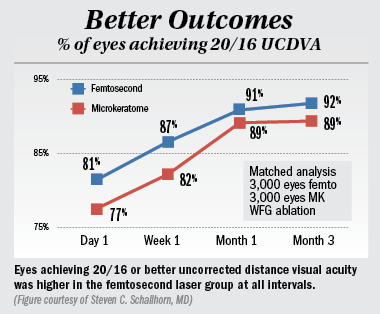Article
Flap creation evolves over technology
Data from analyses of large, retrospective case series show better safety and efficacy when LASIK is performed using a femtosecond laser for flap creation.
TAKE HOME:
Data from analyses of large, retrospective case series show better safety and efficacy when LASIK is performed using a femtosecond laser for flap creation.

Dr. Schallhorn
By Cheryl Guttman Krader; Reviewed by Steven C. Schallhorn, MD
Refractive surgeons can now choose from among many excellent femtosecond lasers for LASIK flap creation. In addition, there are many solid reasons for using this technology rather than a mechanical microkeratome, said Steven C. Schallhorn, MD.
“The femtosecond laser has revolutionized LASIK and is preferred by surgeons and patients,” said Dr. Schallhorn, professor of ophthalmology, University of San Francisco; private practice, San Diego; and chief medical director, Optical Express.
“Using a femtosecond laser instead of a mechanical microkeratome, flap creation is more consistent and more precise,” he said. “In addition, use of the femtosecond laser is associated with fewer intraoperative and postoperative flap-related complications and better safety and efficacy outcomes for LASIK.”
To support his statements, Dr. Schallhorn presented the findings from analyses of data from large cohorts of eyes that underwent LASIK at Optical Express in Europe.
Distance uncorrected visual acuity (UCVA) and best-corrected visual acuity (BCVA) outcomes after wavefront-guided LASIK with a femtosecond laser or mechanical microkeratome for flap creation were evaluated in matched groups of 3,000 eyes each.
Results from follow-up visits at 1 day, 1 week, 1 month, and 3 months showed that the percentage of eyes achieving 20/16 or better distance UCVA was higher in the femtosecond laser group at all intervals, and the difference between groups favoring the femtosecond laser was consistently statistically significant due to the large size of the population studied.
In addition, the rate of BCVA loss of 2 or more lines from baseline was consistently significantly lower in the femtosecond laser group than in eyes that had a mechanical microkeratome-created flap.

Lower rate of complications
Another analysis of data from consecutive series comprising tens of thousands of eyes showed rates of intraoperative and postoperative complications were also significantly lower using a femtosecond laser instead of a mechanical microkeratome for flap creation.
Flap creation complications occurred in about 1 in 700 cases using a mechanical microkeratome compared with 1 in 900 eyes that had a femtosecond laser-created flap, Dr. Schallhorn noted.
“Furthermore, the complications with the microkeratome tended to be ‘showstopping’ events causing LASIK to be aborted,” he said. “However, about half of the flap creation complications with the femtosecond laser involved suction loss, and when that occurs, suction can be reapplied immediately and the flap recut without difficulty.”
The rate of primary epithelial ingrowth was also significantly lower in eyes having a femtosecond laser-created flap than in the mechanical microkeratome group, 0.01% versus 0.02%, and flap displacement during the first year after surgery was significantly less common as well with use of the femtosecond laser than a mechanical microkeratome, 0.03% versus 0.14%, respectively.
“Differences in flap edge geometry between femtosecond laser and mechanical microkeratome flaps likely explain these differences in postoperative flap complication rates,” Dr. Schallhorn said. “A femtosecond laser-created flap with a beveled-in sidecut enables better positioning to reduce epithelial ingrowth risk and results in greater adhesion strength for increased resistance to traumatic dislocation.”
An analysis including data from almost 380,000 consecutive eyes undergoing LASIK, of which about two-thirds had a femtosecond laser-created flap, showed that the risk of postLASIK microbial keratitis was also significantly lower in eyes with a femtosecond laser-created flap than in those where a mechanical microkeratome was used, 0.01% versus 0.02%, respectively.
Dr. Schallhorn also pointed out that the rate of microbial keratitis was significantly lower after LASIK than in a group of 40,000 eyes that underwent PRK, 0.01% vs. 0.03%, respectively.
“There is a tendency to think PRK is safer than LASIK because PRK does not involve a flap. However, the epithelium is removed with PRK, and so it makes sense that the surface ablation procedure is associated with a higher corneal infection risk,” Dr. Schallhorn said.
Data from more than 40,000 LASIK patients also show a clear preference for an all-laser procedure. Even though use of a femtosecond laser for flap creation added $1200 to the procedure fee per patient, 70% of patients chose to undergo LASIK with a femtosecond laser-created flap.
“Not only is there a clear preference for the femtosecond laser, but patients are willing to pay a substantial fee for that preference,” Dr. Schallhorn said.
Steven C. Schallhorn, MD
Dr. Schallhorn is a consultant to Abbott Medical Optics.
Subscribe to Ophthalmology Times to receive the latest clinical news and updates for ophthalmologists.
Newsletter
Don’t miss out—get Ophthalmology Times updates on the latest clinical advancements and expert interviews, straight to your inbox.




